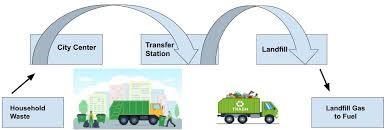As technology advances, waste management is transitioning from traditional practices to smarter and more efficient systems. The rise of the Internet of Things (IoT) offers revolutionary solutions for environmental monitoring and resource optimization in landfills. By integrating IoT with methane detection technologies, we can create a highly intelligent waste management system capable of real-time monitoring, data analysis, and automated control.
Challenges of Methane Emissions in Landfills
Landfills are one of the largest anthropogenic sources of methane emissions worldwide. Methane, a colorless and odorless gas, is a potent greenhouse gas with a global warming potential 25 times greater than carbon dioxide. Beyond its environmental impact, elevated methane concentrations in landfills can pose safety hazards, such as fires or explosions. Effective methane monitoring is critical for mitigating these risks and ensuring operational safety.
Traditional methods of methane monitoring rely on manual sampling and laboratory analysis, which are time-consuming and insufficient for the dynamic and complex environments of landfills. This has highlighted the pressing need for intelligent, real-time monitoring solutions.
Revolutionizing Methane Detection with IoT
IoT brings transformative changes to landfill methane monitoring. Combining sensor networks, wireless communication, and cloud computing, IoT systems enable real-time data collection and visualization for landfill operators.
For instance, drones equipped with advanced methane detectors act as “aerial sentinels,” swiftly covering large landfill areas and providing a comprehensive overview of methane concentrations. Ground-based sensor networks complement this by offering continuous, localized monitoring over extended periods. Advanced methane detection devices with features such as rapid response times (as short as 10 milliseconds), long-range detection (up to 300 meters), and precise geolocation capabilities ensure high accuracy and efficiency in data collection.
Real-Time Data Analysis and Decision-Making
The core of a smart landfill lies in its ability to analyze data in real time. IoT platforms collect methane data and transmit it to cloud-based systems, where advanced algorithms analyze trends and predict future emissions.
For example, when a specific area of the landfill exhibits rising methane levels, the system can immediately alert operators to investigate and address potential leaks. By leveraging predictive analytics, these platforms can also recommend preventive maintenance measures, such as repairing ventilation systems or optimizing waste coverage strategies, to reduce future risks.
Furthermore, these insights help operators refine long-term landfill management strategies. Identifying patterns in methane emissions across different sections of a landfill allows for optimized waste layering and enhanced operational efficiency.
Building Automated Control Systems
The integration of IoT and methane detection technologies extends beyond monitoring and analytics to automation. In smart landfills, monitoring systems can be directly connected to methane capture and venting systems. For instance, when methane concentrations in a particular area exceed safe thresholds, the system can automatically activate venting mechanisms or redirect the gas to collection facilities for energy recovery.
Such automation significantly reduces labor costs and enhances both operational safety and environmental sustainability. By converting captured methane into energy, landfills can transform from waste repositories into renewable energy hubs, further advancing global sustainability goals.
The Future of Smart Landfills
The continuous evolution of IoT and sensor technologies points to a promising future for smart landfills. With the integration of artificial intelligence (AI), future systems will deliver even greater accuracy in methane leakage predictions and risk assessments. The incorporation of low-earth-orbit satellite communication technology will enable remote monitoring of landfills in isolated or hard-to-reach areas.
Additionally, the widespread adoption of 5G technology will support faster and more reliable data transmission, enabling complex systems to operate seamlessly. When combined with other emerging environmental technologies, smart landfills have the potential to play a critical role in achieving sustainable development goals.
Conclusion
The integration of IoT and methane detection technologies is revolutionizing landfill management. By enabling real-time monitoring, data-driven decision-making, and automated control, these systems improve the efficiency, safety, and environmental impact of landfills. Beyond reducing methane emissions, these technologies pave the way for landfills to become resource-efficient and environmentally sustainable. The transition to smart landfills exemplifies the power of innovation in addressing global environmental challenges.


